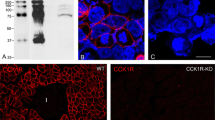Summary
Methods for light and electron microscopic comparison of individual argentaffin and argyrophil enterochromaffin cells (EC) in the sheep duodenal mucosa are described. These silver procedures were applied for light microscopy to Epon-embedded sections. The adjacent sections were examined with the electron microscope. The most specific characteristics of the argentaffin and argyrophil EC in electron microscopy are highly osmiophilic cytoplasmic granules. In one cell type these granules are smaller and more roundish than in the another type. These two cell types are stainable both by the argentaffin and argyrophil reactions. No essential difference can be observed in the localization of these elements. It is suggested that both cell types belong to the enterochromaffin system. Both silver methods are also suitable for the light microscopic identification of other intestinal structures in sections adjacent to that sectioned for electron microscopy.
Similar content being viewed by others
References
Barter, R., Pearse, A. G. E.: Detection of 5-hydroxytryptamine in mammalian enterochromaffin cells. Nature (Lond.) 172, 810 (1953).
Bodian, D.: A new method for staining nerve fibres and nerve endings in mounted paraffin sections. Anat. Rec. 65, 89–97 (1936).
Carvalheira, A F., Welsch, U., Pearse, A. G. E.: Cytochemical and ultrastructural observations on the argentaffin and argyrophil cells of the gastro-intestinal tract in mammals, and their place in the APUD series of peptide-secreting cells. Histochemie 14, 33 (1968).
Christie, A. G. E.: A study of the Kultschitzky (argentaffin) cell with the electron-microscope, after fixation by osmium tetroxide. Quart. J. micr. Sci. 96, 295–299 (1955).
Erspamer, V.: Cellule enterochromaffini e cellule argentophile nel pancreas dell'uomo e dei mammiferi. Z. Anat. Entwickl.-Gesch. 107, 574–619 (1937).
—: Caratteristiche delle cellule enterochromaffini e delle cellule preenterochromaffini argentofile. Anat. Anz. 86, 379–388 (1938).
—, Asero, B.: Identification of enteramine, the specific hormone of the enterochromaffin cell system, as 5-hydroxytryptamine. Nature (Lond.) 169, 800–801 (1952b).
Falck, B., Bertler, Å., Hillarp, N.-Å., Rosengren, E., Torp, A.: Dopamine and chromaffin cells. Acta physiol. scand. 47, 251–258 (1959).
Hamperl, H.: Über die „gelben (chromaffinen)“ Zellen im Epithel des Verdauungstraktes. Z. mikr.-anat. Forsch. 2, 506–535 (1925).
—: Über argyrophile Zellen. Virchows Arch. path. Anat. 321, 482–507 (1952).
Hasegawa, T.: Über die Carcinoide des Wurmfortsatzes und des Dünndarmes. Virchows Arch. path. Anat. 244, 8–37 (1923).
Helander, H. F.: A preliminary note on the ultrastructure of the argyrophile cells of the mouse gastric mucosa. J. Ultrastruct. Res. 5, 257–262.
Hellweg, G.: Über Vorkommen und gegenseitiges Verhalten der argentaffinen und argyrophilen Zellen im menschlichen Magen-Darmtrakt. Z. Zellforsch. 36, 546–551 (1952).
Kay, D. H.: Techniques for electron microscopy, 2nd ed., p. 304. Oxford: Blackwell Scientific Publications 1965.
Lee, D.-H.: Identification of argyrophilic cells in pancreatic islets by light and electron microscopy in osmium-fixed plasticembedded sections. Z. Zellforsch. 77, 1–7 (1967).
Luft, J. H.: Improvements in epoxy resin embedding methods. J. biophys. biochem. Cytol. 9, 409–414 (1961).
Masson, P.: La glande de l'intestin chez l'homme. C. R. Acad. Sci. (Paris) 158, 59–61 (1914).
Munger, B. L.: Staining methods applicable to sections of osmiumfixed tissue for light microscopy. J. biophys. biochem. Cytol. 11, 502–506 (1961).
Pearse, A. G. E.: Histochemistry, theoretical and applied. London: J. & A. Churchill, Ltd. 1960.
Penttilä, A.: Histochemical reactions of the enterochromaffin cells and the 5-hydroxytryptamine content of the mammalian duodenum. Acta physiol. scand. 69, Suppl. 281, 1–77 (1966).
—: Enterochromaffin cells and 5-hydroxytryptamine in the alimentary canal of the guinea pig. Scand. J. clin. Lab. Inv. 19, Suppl. 95, 50 (1967a).
—: 5-Hydroxytryptamine in the enterochromaffin cells of the guinea pig alimentary tract. Histochemie 11, 185–194 (1967b).
Penttilä, A.: Effect of incubation in Krebs-Ringer solution or humid air on the amine content, fluorescence and staining characteristics of the duodenal enterochromaffin and dopamine cells. Virchows Arch. Abt. B Zellpath. 1, 269–282 (1968a).
—: The differentiation of enterochromaffin cells in the chicken duodenum during embryonic development. Z. Zellforsch. 91, 380–390 (1968b).
Richardson, K. G., Jarett, L., Finke, E. H.: Embedding in Epoxy resins for ultrathin sectioning in electron microscopy. Stain Technol. 35, 313–323 (1960).
Singh, I.: On the alleged presence of non-argyrophile argentaffin cells in the human gastrointestinal tract. Z. Zellforsch. 59, 615–624 (1963).
—: Further observations on the alleged presence of non-argyrophile argentaffin cells in the human gastro-intestinal tract. Z. Zellforsch. 62, 121–124 (1964a).
Toner, P. G.: Fine structure of argyrophil and argentaffin cells in the gastro-intestinal tract of the fowl. Z. Zellforsch. 63, 830–839 (1964).
Trier, J. S.: Structure of the mucosa of the small intestine as it relates to intestinal function. Fed. Proc. 26, 1391–1404 (1967).
Trump, B. F., Smuckler, E. A., Benditt, E. P.: A method for staining epoxy sections for light microscopy. J. Ultrastruct. Res. 5, 343–348 (1961).
Wetzstein, R., Doerfler, W., Schwink, A.: Die Feinstruktur der enterochromaffinen Zellen und ihrer spezifischen Granula. Elektronenmikroskopische Untersuchungen am Duodenum des Meerschweinchens. Protoplasma (Wien) 55, 303–312 (1962).
Wood, J. G.: Electron microscopic localization of 5-hydroxytryptamine (5HT). Tex. Rep. Biol. Med. 23, 828–837 (1965).
Author information
Authors and Affiliations
Additional information
This work was supported by a grant from the Yrjö Jahnsson Foundation, Helsinki, Finland.
The electron microscopic observations were carried out in the Electron Microscope Laboratory, University of Helsinki.
Rights and permissions
About this article
Cite this article
Penttilä, A. Identification of enterochromaffin cells in adjacent Epon-embedded sections at light and electron microscopic levels. Z. Zellforsch. 102, 193–204 (1969). https://doi.org/10.1007/BF00335500
Received:
Issue Date:
DOI: https://doi.org/10.1007/BF00335500




